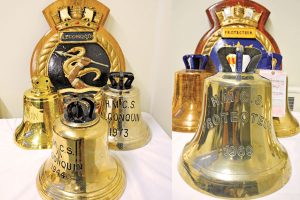Ships’ bells carry on naval tradition
By Lookout on Apr 30, 2016 with Comments 0

Ships’ bells from the two former HMCS (Her Majesty’s Class Ships) the Protecteur and the Algonquin.
Rachel Lallouz, Staff Writer ~
As the final outgoing Executive Officer of detachment Algonquin, Lt(N) Doug Totten has been tasked with collecting and sorting through all of the decommissioned ship’s artefacts, most notably the ship’s bell.
“I feel honoured to have this job. This is part of my duty as the last officer for HMCS Algonquin, and it’s a very important one,” says Lt(N) Totten.
He says a ship’s heavy brass bell, weighing in excess of 30 pounds, is a familiar sight to young crew members who are often given the job of polishing them until they are pristine.
Every ship commissioned in the Royal Canadian Navy (RCN) is given a bell; historically they were used to mark the passage of time at sea or to communicate to other ships on the open ocean.
The oldest bell presented to the CFB Esquimalt Naval and Military Museum dates from 1944 and comes from HMS Valentine, the ship that became the first HMCS Algonquin.
Because HMS Valentine had battle honours, this particular bell would have seen Second World War conflict firsthand.
Lt(N) Totten and museum staff ensured the bells of former HMCS Algonquin and former HMCS Protecteur were added to the collection of over 20 bells from former warships. In the future it is hoped they will go on display for all to see.
Ship bells are especially sacred to sailors because they have been traditionally used as baptismal fonts for shipboard christenings.
“If a sailor aboard a particular ship would like to christen their child while alongside a naval base harbour, the bell is placed into a special holder by the padre, who dips it into the ocean, filling it with seawater.
That water is used to christen the sailor’s baby,” says Lt(N) Totten.
Afterwards, the baby’s name is engraved on the bell, forever connecting the baby to the naval legacy of their parent and the ship.
“For sailors, a ship’s bell is the ship’s soul,” says Lt(N) Totten.
The bells will be stored in a historical archives room in dockyard, where they can be made available to visitors who have had sons or daughters christened with them.
With files from Clare Sharpe, CFB Esquimalt Naval and Military Museum Exhibit Designer and Webmaster.
Filed Under: Top Stories
About the Author:





